Building the perfect bug out bag is one of the biggest challenges the average prepper takes. You’re trying to create a pack which has everything you could possibly need, for whatever emergency you might run across that causes you to abandon your home, but doing it without knowing what that emergency is going to be. No wonder it’s challenging.
In order to help us with this dilemma, there are countless lists of what a bug out bag should include. While any of those lists alone looks good, the confusion begins when we start comparing them to each other.
There are always differences, and the things that each list adds always seem like good ideas. But if we try to take all those things with us, we’ll end up with a bug out bag that weighs so much, we can’t even manage to leave home.
Ideally, a bug out bag should weigh about 20% of your body weight. But there’s a catch to that. That 20% figure is based on lean weight. So you don’t get to carry a 50 pound pack if you weigh 250 pounds, laughing at your 150 pound buddy who’s trying to fit everything into a 30 pound pack.
If anything, a 250 pound person would probably have more of a struggle with that 30 pound pack than a 150 pound person does, unless that’s 250 pounds of lean muscle.
Thirty pounds really isn’t a lot; not when you’re trying to take everything you might need to have, regardless of what happens. Of course, you could work on improving your physical conditioning, allowing you to increase that pack size, without giving yourself a heart attack.
Related: 11 Items You Shouldn’t Have in your Bug-Out Bag
Soldiers and Marines fighting in the Middle East typically carried somewhere between 60 and 100 pound. That’s a whole lot more than I carried, back when I was in the Army.
Of course, that’s not all their pack. It includes weapons, spare magazines, body armor and spare batteries. Still, this shows what can be done, if someone is in shape.
Make Redundancy Work For You
There’s an adage in the prepping community that “two is one and one is none.” That actually came from the Navy SEALS and it’s a pretty good idea.
But before we start putting two of everything in our bug out bags, we need to make sure that we really need two. For that matter, we need to make sure we actually need one.
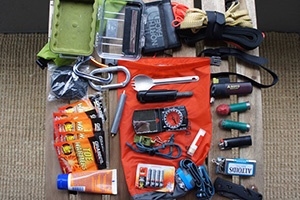 The idea really isn’t to carry two of everything; it’s to build redundancy of capability. That’s a whole other thing. In other words, when it comes to having a way to start a fire, always be sure to have a second way, something that’s different than the first. The same goes for purifying water, cutting wood and any other survival task you can think of.
The idea really isn’t to carry two of everything; it’s to build redundancy of capability. That’s a whole other thing. In other words, when it comes to having a way to start a fire, always be sure to have a second way, something that’s different than the first. The same goes for purifying water, cutting wood and any other survival task you can think of.
The second part of this is that the second one doesn’t have to be as big, fancy, or easy to use as the first, just as long as it works. Take your knife, your primary survival tool. You probably have some sort of a nice sheathe knife for your primary. But that doesn’t mean you need another sheathe knife for your backup.
Go for something smaller, like a folding pocket knife. If you’re carrying a multi-tool, then let it be your backup knife. Just make sure it’s a good one.
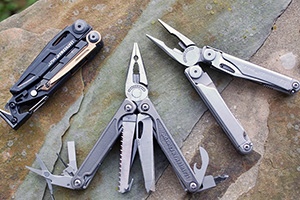 Buying gear that provides multiple capabilities is great, just as long as it is quality gear. Some tools that do multiple things are poor quality, created to dazzle you with all they can do, but will break in actual use.
Buying gear that provides multiple capabilities is great, just as long as it is quality gear. Some tools that do multiple things are poor quality, created to dazzle you with all they can do, but will break in actual use.
So while it’s a good idea to have tools which can serve multiple purposes, make sure you put them through their paces, testing them out in real life to make sure they won’t break at a critical moment.
Related: 13 Weird Survival Tools Every Prepper Should Stockpile
How Heavy Was That?
Another factor to consider in your purchases, is the weight of each individual item. Many things manufactured for the prepping and survival community have been developed without thinking about weight. So the weight adds up quickly, making that 30 pounds disappear.
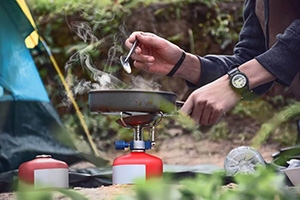 Granted, quality items are often heavier, especially when we’re talking about tools. But you can get quality and strength by going with lightweight, strong materials, especially titanium. Titanium cookware, for example, is lighter than aluminum.
Granted, quality items are often heavier, especially when we’re talking about tools. But you can get quality and strength by going with lightweight, strong materials, especially titanium. Titanium cookware, for example, is lighter than aluminum.
So, while aluminum is less costly from a financial point of view, titanium wins for most serious backpackers, by saving a couple of ounces.
Serious backpackers are sticklers for weight, willing to pay higher prices for just about everything, just to save a few ounces here and there. Having spent enough time on the high trails myself, I can see the advantage of this.
While I can’t say that my bug out bag is the epitome of lightweight, I’ve made a number of my choices based primarily on the item’s weight. Let me give you a few examples:
- I bought a ripstop nylon rain poncho, even though it cost 3x as much, because it was lighter than a typical plastic one. It also breathes, so it’s more comfortable to wear.
- I spent 4x as much money on an ultralight backpacking tarp, replacing one of the cheap blue ones, because it was about ¼ the weight.
- I switched from an aluminum cookware set to a titanium one because it was half the weight.
At the same time, there are some things you can save weight on, by totally changing what you use. I had a folding shovel in my kit for years, something similar to the “entrenching tool” that I carried during my Army days.
But finally, I realized I’d never have to dig a foxhole, so I replaced it with a Hori, which allows me to dig anything I need to, but is about the size of a sheathe knife. That Hori was less than 1/3 the weight of the entrenching tool.
Get The Right Pack
Don’t forget about your pack, when you’re looking for places to save weight. Some tactical packs that people use for bug out bags can weigh as much as five or six pounds empty. That’s too high a percentage of your overall weight. You’re better off with something that’s in the two to three pound range.
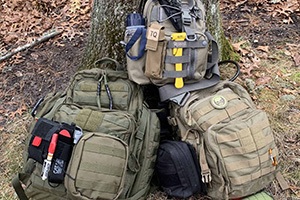 Make sure that your pack has a good internal frame and a well-padded, comfortable belt as well. Avoid any pack that has features you aren’t going to use; that’s just extra weight you don’t need to be carrying.
Make sure that your pack has a good internal frame and a well-padded, comfortable belt as well. Avoid any pack that has features you aren’t going to use; that’s just extra weight you don’t need to be carrying.
For example, a pack which is designed for use with a camelback water bladder is only going to help you if you’re going to be bringing that water bladder with you. if not, you’ve got nothing but wasted space.
A pack which conforms to your body, hugging close to you and not sticking out a long ways is going to be more comfortable to carry, making the weight seem lighter.
Many tactical rucksacks stick out a good 10” to 12”. That puts the weight far behind your hips, throwing you off balance and making the weight seem heavier.
Related: 11 Smart Tips to Make Your Bug-Out Bag Lighter and Smaller
Pack It Right
No matter how you try and cut weight, you’re eventually going to hit a hard floor, where you don’t feel like there’s anything else you can get rid of. Even so, you can make that pack seem lighter, even if you can’t make it be lighter. It’s all a matter of how you pack it.
Remember what I just said about a pack that sticks out too far throwing you off balance?
Many people have that problem, for no other reason than the way they’ve packed their pack.
The secret is to load the pack in the right way, so that the weight is where it needs to be, up close to your body, where it will transfer well to the belt; not out far away from your body, where it will be pulling on the straps.
Your legs are the strongest muscles in your body. They’re used to carrying weight around all day. So, weight that is transferred to your hips by the pack’s belt is going to be weight that is easier to carry; in other words, it’s going to seem lighter and easier to carry, even though it weighs the same.
So, what you want to do is:
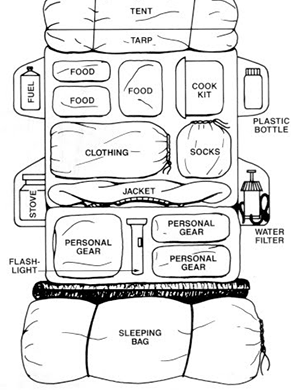 Put your sleeping bag on the bottom, at or below the centerline of the belt. Many backpackers attach it under the pack, with straps.
Put your sleeping bag on the bottom, at or below the centerline of the belt. Many backpackers attach it under the pack, with straps.- Place the medium weight items, like food, in the bottom of the pack, at the level of the top of the belt and slightly above it.
- Place the heaviest items, like tools, above the medium weight items, close up against your back. These shouldn’t extend more than 50% of the way through the thickness of the pack.
- Place the light items to the outside of the heavy ones, and on top.
Of course, there will be some exceptions to this, for a few tools that you might need ready access to, such as a hatchet. But then, those are best hung from your belt, where you can get to them easily.
Try It Out
Once you get your bug out bag all put together and packed the way you want, test it out. Go on an overnight or weekend long backpacking trip somewhere, so you can see how it does.
How well does all your gear work? Are you carrying everything you need? Is there anything you’re carrying, which is a waste of space and weight?
Building a bug out bag is more of a process, than a destination. Don’t be surprised if you have to make changes after trying it out, or find a better piece of equipment than what you’ve got. I’ve been working on mine for years, and I’m still tweaking the design.

No comments:
Post a Comment